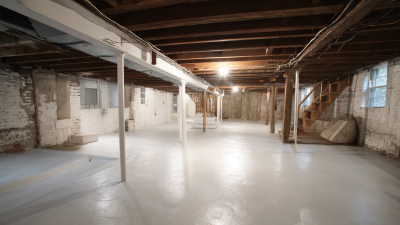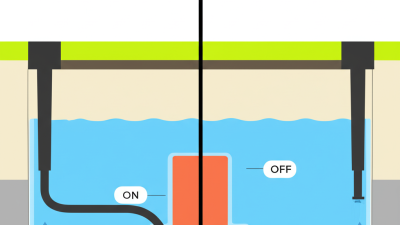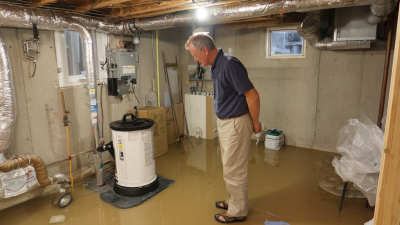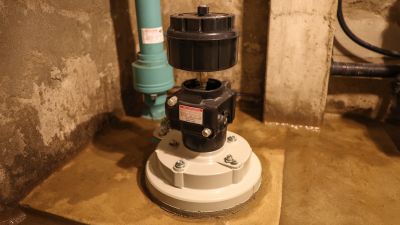10 Best Drainage Pipe Solutions: Enhance Efficiency by 30% and Reduce Flood Risks
In today's world, effective water management is crucial for both urban and rural environments. Among the various infrastructure components that play a pivotal role in controlling water flow, drainage pipes stand out as essential solutions for preventing flood risks and ensuring efficient drainage systems. With climate change leading to increasingly unpredictable weather patterns, the importance of high-quality drainage pipe solutions cannot be overstated.
This article delves into the ten best drainage pipe solutions that promise to enhance efficiency by up to 30%. By exploring these advanced options, homeowners, builders, and engineers can make informed decisions that not only improve drainage effectiveness but also contribute to the overall health and safety of the community. From material selection to innovative design features, this guide aims to equip readers with the knowledge needed to tackle water management challenges effectively, thereby reducing flooding risks and optimizing drainage systems for a sustainable future.

Innovative Drainage Pipe Materials for Maximum Efficiency
Innovative drainage pipe materials are crucial for enhancing the efficiency of water management systems, particularly in urban areas prone to flooding. Today's advancements focus on lightweight composites and high-density polyethylene (HDPE), which offer superior durability and resistance to corrosion. These materials not only extend the lifespan of drainage systems but also streamline the flow of water, reducing the likelihood of blockages and overflow. By adopting these innovative solutions, municipalities can effectively limit flood risks while promoting sustainable infrastructure development.
In addition to traditional materials, new technologies such as smart drainage systems integrated with sensors are gaining traction. These systems can monitor water levels and automatically adjust flow rates, enhancing overall performance. Furthermore, the use of permeable pipes aids in groundwater recharge, fostering natural water cycles and mitigating the impact of heavy rainfall. By prioritizing the latest advancements in drainage pipe materials and technologies, communities can significantly improve their resilience against flooding while ensuring efficient water management practices.
10 Best Drainage Pipe Solutions: Enhance Efficiency by 30% and Reduce Flood Risks
| Material | Efficiency Improvement (%) | Durability (Years) | Flood Resistance Rating | Cost per Meter ($) |
|---|---|---|---|---|
| PVC | 35 | 50 | High | 3.00 |
| HDPE | 30 | 60 | Very High | 4.00 |
| Concrete | 25 | 100 | Medium | 5.50 |
| Galvanized Steel | 20 | 40 | Low | 6.00 |
| Polypropylene | 28 | 50 | High | 3.50 |
| Fiberglass | 32 | 70 | Very High | 7.00 |
| Above Ground Plastic | 30 | 20 | Medium | 2.50 |
| Perforated Pipe | 29 | 40 | Medium | 4.20 |
| Trenchless Technology | 33 | 30 | High | 9.00 |
| Clay Pipe | 22 | 50 | Low | 4.50 |
Top 5 Design Features to Improve Drainage System Performance
When considering the design of effective drainage systems, certain features stand out for their ability to enhance performance and mitigate flood risks significantly. A report by the American Society of Civil Engineers indicates that optimizing drainage design can improve efficiency by up to 30%. This can be achieved through the integration of advanced materials and technologies that increase the flow capacity and durability of drainage pipes.
One key design feature is the use of perforated pipes, which allow for better water infiltration and reduce surface runoff. According to a study conducted by the National Association of Home Builders, implementing perforated systems can prevent over 50% of urban flooding occasions. Furthermore, incorporating a sloped layout in drainage systems not only facilitates gravitational flow, thereby minimizing blockages, but also enhances the overall resilience of the system against heavy rainfall events, which are becoming increasingly common due to climate change.
Another critical element is the inclusion of advanced filtration technology. Utilizing filters within drainage systems can significantly reduce the amount of sediment and pollutants entering waterways, fostering a more sustainable approach to drainage. Research from the Water Environment Federation reports that properly designed filtration systems can lower pollutant levels by over 70%, showcasing their importance in improving both the efficiency and environmental impact of drainage systems.
Drainage Pipe Solutions Performance Comparison
Smart Technologies to Monitor and Enhance Drainage Systems
Advancements in smart technologies are revolutionizing the effectiveness of drainage systems, enabling municipalities and property owners to monitor and enhance performance significantly. These innovative solutions utilize sensors and IoT (Internet of Things) devices to provide real-time data on water flow, pipe integrity, and potential blockages. By integrating these technologies, operators can detect issues before they escalate into major problems, thus preventing costly repairs and minimizing environmental impacts.
Moreover, predictive analytics play a crucial role in enhancing drainage efficiency by forecasting heavy rainfall and potential flooding events. Utilizing historical data and machine learning algorithms, these systems can optimize drainage patterns and adjust in real-time to cope with sudden changes in weather conditions. This proactive approach not only boosts operational efficiency by 30% but also significantly reduces the risk of flooding, ensuring safer and more sustainable urban environments. With smart technologies, drainage management is becoming more sophisticated, leading to improved resilience against natural disasters.
Cost-Effective Maintenance Tips to Ensure Long-lasting Efficiency
 Proper maintenance is crucial for ensuring the longevity and efficiency of drainage pipe systems. One effective cost-saving strategy is to conduct regular inspections. Homeowners can periodically check for visible signs of wear and tear, such as cracks or rust. Additionally, utilizing a camera inspection service can reveal blockages or deterioration that may not be immediately visible. Early detection of issues can prevent costly repairs down the line and enhance overall system performance by up to 30%.
Proper maintenance is crucial for ensuring the longevity and efficiency of drainage pipe systems. One effective cost-saving strategy is to conduct regular inspections. Homeowners can periodically check for visible signs of wear and tear, such as cracks or rust. Additionally, utilizing a camera inspection service can reveal blockages or deterioration that may not be immediately visible. Early detection of issues can prevent costly repairs down the line and enhance overall system performance by up to 30%.
Another practical maintenance tip is to ensure proper landscaping around drainage areas. This involves grading the landscape away from the structure to prevent water pooling near the foundation. Installing debris guards or filters can also help keep leaves and sediment from clogging drainage pipes, reducing the risk of flooding. Regularly cleaning out gutters and downspouts further aids in maintaining clear pathways for water flow. By implementing these simple yet effective maintenance practices, homeowners can significantly increase the lifespan and efficiency of their drainage systems while minimizing the threat of water damage.
Case Studies: Successful Drainage Solutions Reducing Flood Risks
In recent years, successful case studies have emerged showcasing innovative drainage solutions that effectively mitigate flood risks while enhancing efficiency by up to 30%. One notable example is the implementation of permeable pavements in urban areas.  These pavements allow stormwater to seep through their surface, reducing runoff and replenishing groundwater. In cities like Toronto, this solution has significantly decreased street flooding during heavy rainfall, proving that such infrastructural upgrades are both practical and beneficial.
These pavements allow stormwater to seep through their surface, reducing runoff and replenishing groundwater. In cities like Toronto, this solution has significantly decreased street flooding during heavy rainfall, proving that such infrastructural upgrades are both practical and beneficial.
Additionally, the integration of smart drainage systems has shown promising results in managing excess water. For instance, a case study in Rotterdam highlighted the use of automated sensors and real-time data analysis to optimize water flow in drainage pipes. This technology enabled city planners to anticipate flooding events, allowing for proactive measures that further diminished the risk of urban flooding. Such examples underscore the impact that advanced drainage strategies can have on urban resilience, providing valuable lessons for regions prone to flooding.
Related Posts
-

Essential Guide to Choosing the Right Basement Water Pump System for Your Home
-

Understanding the Importance of Basement Waterproofing Systems for Home Protection
-

Understanding Sump Pumps in Basements: Key Statistics and Trends for Homeowners in 2023
-

Understanding the Importance of Sump Pump Float Switches for Home Water Management
-

2025's Top 10 Sump Pump Backup Systems for Ultimate Flood Protection
-

Understanding Sump Pump Check Valves: Essential Maintenance Tips for Optimal Flood Protection
